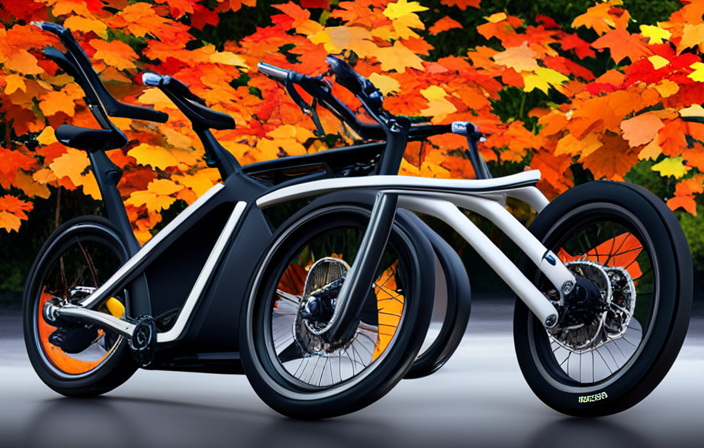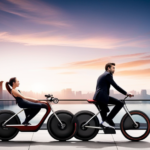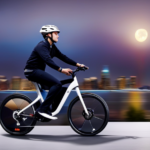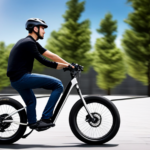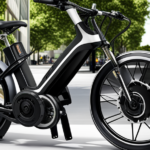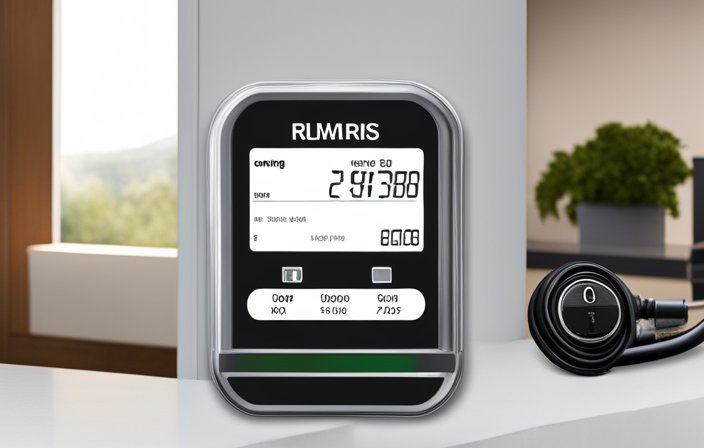Have you ever pondered over the ease with which electric bikes ascend hills and cover vast distances? This capability stems from the pedal assist feature. Acting as an inconspicuous support, pedal assist amplifies your pedaling effort, ensuring a more fluid and efficient journey.
In this article, we will delve into the intricacies of pedal assist, exploring how it works, its benefits, and how to choose the right level for your needs.
Get ready to unlock the full potential of your electric bike with pedal assist.
Key Takeaways
- Pedal assist on an electric bike refers to a feature that provides assistance to the rider while pedaling.
- Pedal assist works by using sensors to detect the rider’s pedaling motion and then activating the electric motor to provide additional power.
- The benefits of pedal assist include easier uphill climbs, reduced effort for longer rides, and the ability to ride at higher speeds with less exertion.
- To maintain and troubleshoot pedal assist systems, regular maintenance is necessary for optimal motor performance, and common issues can be resolved by checking and adjusting pedal assist settings.
Understanding Pedal Assist Technology
You can easily understand how pedal assist technology works on an electric bike. With pedal assist customization, you have the ability to choose the level of assistance provided by the motor when you pedal. This allows you to have complete control over the amount of effort you want to exert while riding.
Unlike throttle control, where you simply twist a handle to engage the motor, pedal assist requires you to pedal in order for the motor to kick in. The level of assistance can be adjusted to suit your preference, whether you want a gentle boost or a more powerful acceleration.
Understanding how pedal assist works is essential for maximizing your riding experience.
How Pedal Assist Works
Pedal assist on an e-bike works by providing additional power when you cycle. This technology allows you to ride longer distances and tackle challenging terrains with ease. To understand how pedal assist works, let’s look at a simple table that shows the different levels of assistance and what they mean:
| Assist Level | Power Output | Effort Required |
|---|---|---|
| Low | 50% | Minimal |
| Medium | 75% | Moderate |
| High | 100% | Intense |
You can adjust the pedal assist level according to your preference and the terrain you’re riding on. By choosing a lower level, you can maximize your battery life and ride for longer periods. This feature is particularly useful when you’re on long journeys or want to conserve battery power. Understanding how to adjust pedal assist levels and maximize battery life while using it will greatly enhance your e-bike experience. It’s important to note that these benefits of pedal assist go beyond just providing additional power – they also make your rides more enjoyable and efficient.
Benefits of Pedal Assist
One of the advantages of using pedal assist on an e-bike is that it allows riders to cover longer distances with less effort. This is possible because pedal assist technology provides an additional boost to your pedaling power, making it easier to climb hills or maintain higher speeds.
Another benefit of pedal assist is the customization options it offers. Most e-bikes allow you to choose different levels of assistance, so you can tailor the amount of boost to your preference or the terrain you’re riding on. This not only gives you more control over your ride but also helps conserve energy by using only the assistance you need.
Considering these benefits, it’s important to understand how to choose the right pedal assist level for your specific needs and riding conditions.
Choosing the Right Pedal Assist Level
When choosing the right pedal assist level for your electric bike, there are a few key points to consider.
First, you should take into account the terrain and riding conditions you will be encountering. Different levels of pedal assist can help you tackle steep hills or navigate rough terrain with ease.
Additionally, your personal fitness level and comfort should also be taken into consideration. Choosing the appropriate pedal assist level can help you maintain a comfortable pace and avoid fatigue during longer rides.
Terrain and Riding Conditions
To navigate different terrains and riding conditions, you can rely on the pedal assist feature of an electric bike. This feature allows you to adjust the level of assistance provided by the motor, giving you greater control over your ride.
When it comes to riding techniques, you can choose a higher pedal assist level for steep inclines or challenging off-road trails. This will give you the extra power needed to conquer these terrains with ease.
On the other hand, for smooth roads or flat surfaces, you can opt for a lower pedal assist level to conserve battery life and optimize your range.
Additionally, the pedal assist feature also helps in maintaining a consistent and comfortable riding experience, regardless of the terrain or riding conditions.
So, let’s explore how this feature can enhance your personal fitness and comfort.
Personal Fitness and Comfort
Improve your personal fitness and comfort while riding by taking advantage of the pedal assist feature on your e-bike.
Not only does pedal assist provide a boost of power when needed, but it also offers several fitness benefits. By engaging in pedaling, you can strengthen your leg muscles, increase your cardiovascular endurance, and burn calories. This feature allows you to customize your level of exertion, making it suitable for riders of all fitness levels.
Additionally, e-bikes often come with ergonomic designs that prioritize rider comfort. The adjustable seat height, handlebar position, and suspension systems ensure a comfortable riding experience, reducing strain on your body.
Transitioning into the next section about safety considerations, it’s important to note that while pedal assist can enhance your fitness and comfort, it’s crucial to ride responsibly and be aware of the potential risks associated with increased speed and power.
Safety Considerations with Pedal Assist
One important factor to consider regarding pedal assist on electric bikes is the safety aspect. Bike accidents can occur if the rider is not aware of the potential risks associated with using pedal assist. It is crucial to perform a thorough risk assessment before using this feature, as it can significantly increase the speed and power of the bike.
It is essential to understand how the pedal assist system works and adjust the settings accordingly to ensure a safe riding experience. Additionally, it is important to wear appropriate safety gear such as a helmet and reflective clothing to increase visibility on the road. By prioritizing safety and taking necessary precautions, you can enjoy the benefits of pedal assist without compromising your well-being.
Moving on to the next section about maintenance and care for pedal assist systems, it is crucial to ensure proper upkeep to maximize performance and longevity.
Maintenance and Care for Pedal Assist Systems
When it comes to maintaining and caring for pedal assist systems on electric bikes, there are a few key points to keep in mind.
Firstly, battery maintenance and charging are crucial for ensuring optimal performance and longevity. Regularly inspecting the battery for any signs of damage or wear, and following the manufacturer’s guidelines for charging will help keep your pedal assist system running smoothly.
Additionally, motor and sensor maintenance is important for keeping the system functioning properly. Regularly cleaning and lubricating the motor and ensuring that the sensors are free from debris will help prevent any issues.
Lastly, being able to troubleshoot common issues such as sudden loss of power or sensor malfunctions will help you quickly address and resolve any problems that may arise.
Battery Maintenance and Charging
To properly maintain and charge your electric bike’s battery, you should make sure to follow the manufacturer’s recommended guidelines. Battery monitoring is essential to ensure optimal performance and longevity. Regularly check the battery’s charge level and monitor its health using the provided display or app.
It is important to charge the battery in a safe and controlled environment. Avoid extreme temperatures, both hot and cold, as they can negatively affect battery life. Use the charger provided by the manufacturer and avoid using third-party chargers, as they may not provide the correct voltage or current. When charging, make sure to connect the charger securely to the battery and outlet. Once the battery is fully charged, disconnect it from the charger to avoid overcharging.
Now, let’s move on to motor and sensor maintenance.
Motor and Sensor Maintenance
Motor and sensor maintenance is crucial for the proper functioning and longevity of your e-bike. To ensure optimal motor performance, it is important to regularly inspect and clean the motor. Check for any loose connections or signs of wear and tear, such as damaged wires or corroded terminals.
Additionally, make sure the motor is properly lubricated to minimize friction and maximize efficiency. Sensor calibration is equally important, as it ensures accurate and responsive pedal assist. Check the alignment of the sensors and make any necessary adjustments to ensure they are properly positioned.
Regularly test the sensors to ensure they are detecting pedal input correctly. By maintaining the motor and sensors, you can ensure smooth and efficient operation of your e-bike. This will be especially helpful when troubleshooting common issues related to motor and sensor performance.
Troubleshooting Common Issues
If you’re experiencing common issues, troubleshooting can help you identify and resolve them efficiently.
When it comes to electric bikes, there are a few common issues that riders may encounter. One of the most common problems is the pedal assist not functioning properly.
To troubleshoot this issue, start by checking the pedal assist settings on your electric bike. Make sure that it is properly adjusted to your desired level of assistance.
If the pedal assist is still not working, you may need to check the motor and sensor connections to ensure they are securely plugged in. Additionally, inspect the wiring for any signs of damage or wear.
By following these troubleshooting steps, you can quickly identify and fix any issues with the pedal assist system.
Transitioning into the subsequent section about ‘pedal assist in different types of electric bikes’, you can explore the various ways pedal assist is implemented in different models.
Pedal Assist in Different Types of Electric Bikes
When riding different types of electric bikes, you’ll find that pedal assist varies depending on the model. Pedal assist is a feature that provides additional power to your pedaling, making it easier to ride the bike. It is commonly found in various types of electric bikes, including city bikes, mountain bikes, and folding bikes. Each type of electric bike offers its own advantages of pedal assist.
To help you understand the differences, here’s a table highlighting the pedal assist in different types of electric bikes:
| Electric Bike Type | Pedal Assist Level | Advantage |
|---|---|---|
| City Bike | Low | Efficient commuting |
| Mountain Bike | Medium | Uphill assistance |
| Folding Bike | High | Compact and portable |
Understanding the pedal assist level of your electric bike is crucial for maximizing your riding experience. In the next section, we will provide you with tips on how to make the most out of your pedal assist.
Tips for Maximizing Your Pedal Assist Experience
To get the most out of your electric bike’s pedal assist, it’s important to follow these helpful tips:
-
Maximizing Battery Life: Adjust the pedal assist level to a lower setting when riding on flat terrain or downhill to conserve battery power.
-
Efficient Pedaling Technique: Maintain a steady cadence and avoid sudden bursts of pedaling to optimize battery usage.
-
Utilize Gear Shifting: Shift gears to find the most comfortable and efficient pedaling resistance, minimizing strain on the motor.
-
Maintain Proper Tire Pressure: Check and inflate your bike’s tires regularly to reduce rolling resistance and increase battery efficiency.
-
Plan Your Routes: Choose routes with less incline and avoid excessive stop-and-go traffic to maximize the range of your battery.
By following these tips, you can make the most of your electric bike’s pedal assist, maximizing battery life and optimizing your riding experience.
Moving on to pedal assist regulations and laws…
Pedal Assist Regulations and Laws
When it comes to pedal assist on electric bikes, it’s important to familiarize yourself with the local and regional regulations that govern their use. These regulations can vary from place to place, so it’s crucial to know the rules and restrictions in your area.
Additionally, there are speed and power limitations that you must adhere to when using pedal assist, as exceeding these limits can result in legal consequences.
By understanding and following these regulations, you can ensure a safe and legal pedal assist experience.
Local and Regional Regulations
Local and regional regulations may affect the use of pedal assist on electric bikes. Different areas may have their own set of rules and restrictions when it comes to using pedal assist. Regional restrictions can dictate where electric bikes are allowed to be ridden, such as specific bike paths or trails. There may also be legal requirements regarding the use of pedal assist, such as age restrictions or the need for a license.
It is important to familiarize yourself with these regulations to ensure that you are riding your electric bike within the boundaries of the law. Understanding local and regional regulations will help you navigate the legal landscape and enjoy the benefits of pedal assist without any issues.
Now, let’s delve into the next section about speed and power limitations.
Speed and Power Limitations
Now that you understand the local and regional regulations surrounding electric bikes, let’s delve into the speed and power limitations associated with pedal assist. Different regions have specific classifications for pedal-assist systems, which dictate the maximum speed and motor wattage allowed. The PAS on an electric bike typically controls the level of assistance provided, ensuring compliance with these regulations while maintaining a natural riding experience. Understanding these limitations helps riders choose the right e-bike for their needs while staying within legal boundaries.
When it comes to speed, electric bikes are typically limited to a certain maximum speed, often around 20 miles per hour. This ensures the safety of both the rider and others sharing the road or bike path.
Additionally, there are power limitations in place to prevent the motor from providing excessive assistance. This ensures that the rider still needs to put in some effort to pedal, maintaining the health benefits of cycling.
These limitations help strike a balance between the convenience of electric assistance and the integrity of traditional cycling.
Looking ahead, future developments in pedal assist technology aim to enhance the speed and power capabilities of electric bikes while still adhering to safety and regulatory standards.
Future Developments in Pedal Assist Technology
In the future, advancements in pedal assist technology will likely lead to even more efficient and powerful electric bikes. These future innovations have the potential to greatly impact the cycling community.
One area that is expected to see significant improvement is the efficiency of the pedal assist system. Currently, most electric bikes have a pedal assist system that provides a certain level of assistance based on the rider’s input. However, future developments may allow for a more intuitive and responsive system that adjusts the level of assistance in real-time, optimizing the rider’s performance and conserving battery power.
Additionally, advancements in battery technology and motor design may result in more powerful electric bikes with increased range and faster speeds. These improvements will not only enhance the overall riding experience but also encourage more people to adopt electric bikes as a viable mode of transportation.
Frequently Asked Questions
Are electric bikes with pedal assist more expensive than regular electric bikes?
Electric bikes with pedal assist are generally more expensive than regular electric bikes. However, the benefits of pedal assist, such as extended battery life and increased range, justify the higher electric bike prices.
Can I use pedal assist on any type of terrain?
You can use pedal assist on any type of terrain, including steep hills. It provides several benefits such as increased power and torque, making it easier to climb and maintain speed on rough terrain.
Is it possible to ride an electric bike without using pedal assist?
Yes, it is possible to ride an electric bike without using pedal assist. By utilizing alternative power sources such as throttle control, you can ride the bike without the need for pedaling. Different riding techniques can be employed to maximize efficiency and enjoyment.
How long does the battery last when using pedal assist?
When using pedal assist on an electric bike, the battery life can last for an astonishingly long time, allowing you to ride for hours on end. And don’t worry about charging time, as it’s surprisingly quick!
Are there any health benefits to using pedal assist on an electric bike?
Using pedal assist on an electric bike can provide health benefits by increasing physical activity levels. It allows you to engage in a more active ride, promoting cardiovascular fitness, muscle strength, and calorie burning.
Conclusion
Congratulations on completing your journey into the world of pedal assist technology! By now, you have gained a deep understanding of how this incredible innovation works and the numerous benefits it offers.
As you continue on your electric bike adventures, remember to choose the right pedal assist level for the terrain and always prioritize safety. Embrace the thrill of effortlessly gliding through different types of electric bikes, and don’t forget to maximize your pedal assist experience with our helpful tips.
Stay informed about pedal assist regulations and laws, and keep an eye out for future developments in this exciting field.
Happy riding!

